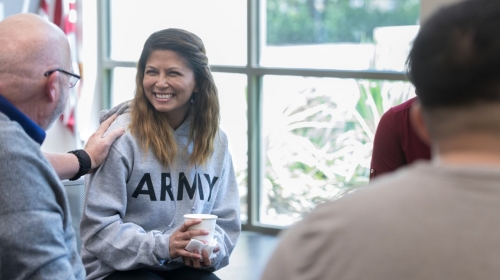This month’s Member Meetup highlighted how companies are supporting veterans and military families through a variety of impactful initiatives.
Skills-Based Volunteering & Pro Bono Services in 2024: Company Insights & Examples

Ten years ago, if you Googled the term “skills-based volunteering,” you might be one of roughly 100 people to do so globally, in any given month. Today, that same search is joined by more than four times as many information seekers. And the resulting web offerings now number more than 72 million. Needless to say, skills-based volunteering (SBV) is gaining momentum.
Our Center research aligns with this growing digital footprint. More than 90% of companies surveyed now offer virtual (not always, but often skills-based) volunteering; nearly 60% offer pro bono services, according to BCCCC’s 2023 Community Involvement Report. Compare this to our Center’s 2019 findings, when the same report found companywide Days of Service to be the most common form of organized employee volunteerism by far. At a recent BCCCC Member Meetup, we also found that more than half of all attendees reported their companies either had SBV programs in place or were in the process of program creation.
Why the shift? The pandemic certainly played a role, with more employees transitioning to hybrid or remote schedules. But nonprofit partners are also eager to see a push toward more sustained and nuanced corporate support wherever possible. Consider, as one example, this commentary from the head of marketing and fundraising at a UK organization fighting homelessness:
“If you are a business looking for volunteer days, please bear in mind that most charities don't have a 1-day project—that will suit 30-60 people—just sitting in their drawer waiting for your team to come along… It's great that your company gives you volunteering days and that you want to use them, but not all charities have a shed to paint, donations to sort, or gardens that need trimming.
Ask your company if you can break your days down into a few hours a week so you can help a charity with consistent, regular help and so you can build a relationship with them. This is invaluable, especially [for] a small charity that relies on their volunteers.”
So, what do skills-based volunteering and pro bono engagements look like in a post-pandemic world? How can companies continue showing up for their communities in scalable ways, while answering the call from organizations that need more consistent support? How can corporate social responsibility (CSR) teams make these different kinds of opportunities work for their stakeholders? This post aims to answer all of the above, with the help of successful program examples from Paramount, Citizens, and FTI Consulting. But first, a bit of context:
What is skills-based volunteering? How does it relate to pro bono services?
SBV programs are initiatives wherein corporate employees offer their professional talents to complete skills-driven tasks for nonprofit partners. In addition to rounding out a company’s community involvement efforts, SBV programs also benefit participating employees, who often find ways to grow their knowledge and competencies while forming valuable connections throughout the process. There is also some evidence to suggest that (skills-based) volunteering supports employee health and wellness objectives. Read more on this below.
While skills-based volunteering and “pro bono” are often lumped together, there are differences between the two. Pro bono work is always skills-based, but skills-based volunteering is not always pro bono. For example, a lawyer who drafts and reviews a nonprofit contract for free is doing skills-based volunteering and offering pro bono services. A lawyer who, instead, mentors local students on the basics of public speaking or resume writing is offering skills-based volunteering, but not pro bono services.
The most important difference is that with pro bono work, employees generally aren’t trying to help build operational capacity within the receiving organization. Pro bono work is more like a client engagement, delivered at no cost.
“Our pro bono engagements should resemble the work we deliver to our clients every day,” explained Hilary McDonald Taubman, corporate citizenship manager, FTI Consulting. “Helping them manage change, mitigate risk, navigate new opportunities, and resolve disputes… We seek to engage in and deliver the same quality of work for organizations and individuals who would not be able to afford our services.”

Why are skills-based volunteers and pro bono partners so in demand, especially post-pandemic?
It’s an unfortunate truth that most of today’s nonprofits are understaffed. Nonprofit employees are forced to wear many hats and do more with less, even if their professional skills don’t necessarily align with all the different jobs that need doing. The pandemic exacerbated staffing shortages at third sector organizations across the country. According to a Fall 2021 survey conducted by the National Council of Nonprofits, “a troubling 26.2% [of charitable organizations] responded that they had job openings for 20 to 29% of their positions; another 16% percent reported vacancies greater than 30%.”
As of April 2023, 52% of nonprofits surveyed say they have more job vacancies now than they did before the pandemic. Stress, burnout, budget constraints, and salary competition are all hindering staffing stability. Even after raising salaries and offering more flexible work options, many organizations still struggle to attract and retain talent. All told, nonprofits need extra hands. They need people who can dive into projects with knowledge and experience. They need corporate employees who are willing to volunteer.
What kinds of skills do nonprofit organizations need?
At FTI Consulting, McDonald Taubman says the firm is most often tapped for the expertise of its communications experts to help with narrative building, social media strategy, PR support, and more. She also sees a significant demand for business strategy, economic evaluations, data analysis, and visualization.
“Nonprofits have vast amounts of data, and often do not have a data person on staff,” she said. “Having the ability to implement a dashboard and streamline their data processes—a simple task for many of our professionals—goes a long way.”
What are the different models of skills-based volunteering?
One reason it’s difficult to find hard numbers associated with skills-based volunteering programs is that SBV can take on many different forms and go by different names. Here are a few of the models we have seen our member companies share and promote:
- Flash consulting or marathon model SBV: Skills-based volunteering projects conducted in a short timeframe (e.g., 2 to 24 hours), which may or may not be incorporated into company-wide days of service
- Open-ended model: SBV services made available to a set number of nonprofits on an ongoing basis
- Micro-volunteering: SBV (or sometimes general volunteer work) that can happen in the span of a coffee break (e.g., drafting a social media post or translating a flyer); micro-volunteering opens SBV to employees with all different types of work schedules
- Coaching and mentoring: Volunteers partner with a nonprofit to lend expertise on an ongoing basis
- Standardized team projects: A volunteer team—built around a specific skillset—is given set roles, responsibilities, and deliverables
- Loaned-employee model or sabbatical: Volunteers take an approved and compensated leave of absence (or sabbatical), committing full-time to a specific nonprofit

Skills-Based Volunteering at Paramount: Talent for Good
Paramount has leveraged several of the aforementioned models over the course of its eight-year history with skills-based volunteering. The company offers SBV as part of its annual Day of Service and Season for Giving campaigns, as well as various ongoing programs, including “Talent for Good.”
Paramount’s “Talent for Good” program began in 2015 (back when the company operated under Viacom). The company utilizes the Catchafire platform—a tool that “sits at the intersection of philanthropy and employee engagement”—to assign virtual, in-person, hybrid, individual, and team volunteer opportunities between community partners and employees. Through a robust matching process, employees submit applications to volunteer on projects of their choice. After completing an interview with the organization, the project moves forward if both the volunteer and organization feel that they are a good fit for one another.
Another addition to this program is an annual day of service event—involving approximately 100 employee volunteers and five or six nonprofits. Each community partner comes to the hackathon style event with a unique challenge they are currently facing, and employees then set to work on two or three hours of brainstorming solutions for those challenges. Before this hackathon begins, employees are pre-matched with the organizations most in need of their skills and talents. The nonprofits come away from the event with a laundry list of actionable items they can tackle right away.
Paramount’s experiential sessions often segue into open-ended engagements with teams of people best equipped to carry the baton. Like many others, the company experienced a virtual volunteering boom during the COVID-19 pandemic. The entertainment leader soon found it made sense to relaunch SBV for all employees globally as a way to further enhance the program’s impact and connect employees across all offices and divisions.
Today, Paramount offers more than 150 different types of volunteer projects through Talent for Good and the Catchafire platform, involving 35 distinct skillsets, according to Rita Papadogiannis, manager, corporate social responsibility. Volunteers come from marketing/communications teams, social media teams, graphic design, web design, photography and videography roles, as well as finance—an increasingly valued skill as nonprofits work to optimize fundraising and address shrinking budgets.
Skills-Based Volunteering at Citizens: Citizens Community Service Sabbatical
At Citizens Financial Group, the concept of an SBV sabbatical program is rooted in the company beliefs.
“[Our credo has] been around for three decades, and it serves as the North Star for everything we do: performing our best every day so we can do more for our customers, colleagues, community, and—now that we are a public company—shareholders,” explained Michelle Hecht, head of corporate affairs at Citizens.
Hecht said the company’s SBV sabbatical program, which first began in the 1990s, is an example of taking one important stakeholder—the colleague—and exploring how to equip that colleague in order to help another, the community.
Citizens’ first iteration sabbatical program took a pause amidst the financial crisis, while the company maintained its commitment to traditional volunteering, shorter-term flash consulting, and other community involvement. Now, in planning the sabbatical program relaunch, Citizens is focused on two key goals: colleague wellbeing and impact for the nonprofit. (Fun fact: Hecht said two of the original SBV program participants will now serve on the selection committee for reviewing new program applicants.) The relaunch is slated to begin in the coming months. Check back for more details on the different types of engagements and outcomes achieved.
“One of the things we did was go out and solicit feedback, both from colleagues and nonprofit partners…,” said Hecht. “We also did [some] research and clearly, right now, you can find insights that support the power of a sabbatical—of enabling a colleague to actually step away from their job, and how it reduces stress. Through all of those conversations, we landed on the timeframe of four to six weeks. We will fine tune that as we talk to the nonprofits, once we go into matchmaking mode, but right now we're giving that as a general guide. So, depending on the needs of the nonprofit, the appetite of the colleague, and the business line that they're from, we will use all of that information to help us decide what the best duration is.”
Pro Bono Services at FTI Consulting
The teams at FTI Consulting was doing pro bono before any formal program existed; the firm has been tracking contributions since at least 2017. But in 2020, leaders recognized renewed momentum following a surge in calls for racial and social justice.
“Our CEO and executive leadership committee hosted a series of small group conversations with professionals around the firm, including a discussion on how we could unite and use our collective expertise to make a difference in our communities and the world more broadly,” explained McDonald Taubman. “As a result, in addition to implementing a formal Diversity, Inclusion and Belonging (DI&B) program, we also formalized the Pro Bono Program by instituting a Global Pro Bono Advisory Committee and allowing professionals to count time dedicated to pro bono work towards their utilization and productivity metrics.”

How do companies find and match opportunities for skills-based volunteering?
The process usually starts with listening to employees—especially when SBV is a global effort, Papadogiannis explained. Paramount team members routinely help organizations in other countries.
“Our goal with this program is to truly make it feel accessible globally. It has been a collaborative effort with our International teams to ensure that we are providing a variety of opportunities that resonate with employees and are onboarding community partners that align with our company’s values. It's a work in progress as we build out those offerings, but we have seen huge success so far. And another plus is that we are beginning to notice a trend of employees volunteering cross-culturally with organizations headquartered in other countries. The opportunities are endless.”
Citizens also takes an employee-centric approach.
“We start with the colleague,” said Hecht. “We introduced the [sabbatical] program and its parameters, and we sent out a variety of internal communications—some broad, but many targeted towards the eligible population—and that generated a great deal of interest.”
In total, Citizens received nearly 100 nominations from 14 different states. The applications are anonymized as they go through a blind review process, which involves the applicants’ different business lines and HR teams.
“Once we determine the colleagues, we'll then look and say, okay, what geography are those colleagues from? Who are the nonprofit partners that we work most closely with in those geographies? And then we'll go out to those nonprofits and make sure we understand what their needs are, and try to do the matchmaking from there,” explained Hecht.
When it comes to pro bono engagements, the leaders at FTI Consulting echo this approach.
“The way we select organizations mirrors the ethos of our broader corporate citizenship program in that we want professionals to give back in ways that are meaningful to them,” shared McDonald Taubman. “A lot of our engagements are grassroots, which means a professional launches a pro bono engagement and then staffs it like they would any other client engagement—internal to their practice. Second, now that we have built a foundation for the program, we are beginning to build partnerships and identify pro bono opportunities for our professionals to engage in. Third, and importantly, the need for our skillsets vary based on the organization. We are careful not to over-extend certain practitioners like our communications experts and data analysts.”
What’s the business case for SBV? What are the benefits of skills-based volunteering?
Apart from improving a brand’s reputation—as virtually any form of community involvement might— investing in skills-based volunteering lends to a better overall employee experience, encourages teambuilding, supports professional learning and development, and creates opportunities for internal mobility.
Research suggests that employee participation in a skills-based volunteer project is positively associated with higher employee retention. In a study of one professional services firm conducted over six years, researchers found that the company benefited from a 36% reduction in attrition rates among employees who participated in a project compared to their non-participating peers. BCCCC’s 2023 Community Involvement report also reaffirmed that employee volunteering of any kind drives engagement. Of the 60% of companies that measure the connection, 91% found a positive link between employee volunteering and employee engagement scores.
Papadogiannis confirms she has seen countless examples of employee volunteers “flexing and strengthening their skills” through Paramount’s SBV programs. By providing opportunities to lean into organizational causes that inspire team members, SBV can build the bond between employee and employer.
“SBV opens doors for employees to showcase their skills to higher ups and supports employee recognition programs. This type of volunteering also helps employees learn new skills, which can lead to career opportunities in the future. But most importantly, skills-based volunteering helps build our community and improves overall wellness. If you feel good about your talents and career, your mental health and wellbeing are also positively impacted,” Papadogiannis shared.
Unlike traditional, one-off volunteering, SBV also gives employees a unique “behind-the-scenes” look at how an organization functions. “It really does create longer-term relationships. I’ve heard stories from employees who have initially participated in the program through a one-hour consultation call, and later signed up for a three-month project…to the point where that one employee eventually became so embedded in the work, they ended up accepting a position on the nonprofit’s board.”
Finally, skills-based volunteers amplify the impact of grants or other financial contributions made to nonprofit partners because it helps those teams grow their bandwidth or develop in-house abilities that were previously lacking. Providing skilled volunteers or pro bono service hours may be especially valuable during periods of economic downturn, when corporate giving budgets tend to shrink.
What are some common challenges when implementing or managing an SBV program?
The biggest obstacle? According to attendees surveyed at BCCCC’s most recent event on SBV, it’s the resources needed to manage a program. That’s why many companies partner with third-party organizations like Catchafire, Taproot, Pyxera Global, or Common Impact.
But plenty of companies are making an impact with homegrown management tools (e.g., Excel spreadsheets) and without a massive employee volunteering budget. In fact, the majority of respondents in BCCCC’s 2023 CI Report are getting it done with less than $50,000 per year.
Hecht offered encouragement for the many companies in this camp with the following advice: “Start small. Test and learn. Take an iterative approach.”
How you promote SBV opportunities to your employees?
Paramount’s Papadogiannis says it’s all about embedding social impact in the company culture.
“We’re fortunate at Paramount, because social impact has been embedded in our company’s culture for 30-plus years. Employees reach out looking for ways to get involved throughout the year, and we have evolved our approach to social impact over time to continuously offer them new and engaging ways to give back.”
To maintain that culture, Paramount incorporates skills-based volunteering offers into its new hire onboarding programs and senior leadership town halls. They also run targeted email campaigns to remind employees of SBV opportunities happening around the company’s annual Day of Service, Season for Giving, and beyond. “Talent for Good is always accessible to any employee at Paramount around the world, 24/7, and 365 days a year,” Papadogiannis emphasized.
Hecht describes a similar culture at Citizens, where colleagues are eager to give back in new and different ways.
“At Citizens, we're very proud of the fact that we have the highest rate of colleague volunteerism amongst all of the financial institutions that we benchmark to,” she said. “We really believe that giving back is part of our DNA.”
Through collaboration and the ability to leverage common goals, Citizens is careful to ensure that SBV, as a program, does not get siloed.
“One of the things we knew was critical to this program’s success was partnering with groups like human resources and connecting this opportunity to the work that they're doing, whether it be work around [learning and] development or work around employee wellbeing.”
Since pro bono engagements are sourced by individual professionals at FTI Consulting, promotion centers more around promoting the pro bono program as opposed to individual opportunities. To do this, the corporate citizenship team works closely with the company’s general counsel to help ramp up efforts to communicate the program’s policy changes, successes, and work that has been done. As a result, FTI Consulting has seen much more engagement from executive leadership committee. The firm also shares pro bono success stories, often illustrated in the form of case studies, on its social media channels, in its corporate sustainability report, on the FTI Corporate Citizenship webpage, and through various internal channels.
How do companies track success or measure impact from skills-based volunteering?
When it comes to impact measurement and skills-based volunteering, some of the more concrete metrics worth tracking include number of volunteers, number of volunteer hours, projects completed, or dollars saved by the nonprofit (an approximate value for any work completed).
Additional metrics may be extracted from the nonprofit side, depending on the project work done. For example, team members who helped with marketing and communications may be able to share how much traffic, engagement, brand awareness, donor lists, or actual donation dollars grew, as a result of the skills volunteered.
In total, Paramount can proudly say employees have helped organizations save approximately $3 million, across 4,000 hours of SBV volunteering through Talent for Good. “[Through Catchafire] we’re able to translate the number of hours donated into direct dollars and hours saved by organizations and estimate a price tag on the materials we’ve created. When we calculate the amount of funds organizations save through the program and can direct back into programming for beneficiaries, that’s where the true value of the program lies. We are able to help so many more people just by lending our skills and time to great causes,” Papadogiannis shared.But she cautions against focusing too strictly on the hard numbers of SBV.
“For me, some of the most meaningful impact comes from the shared experiences between our employees and community partners.” Notably, to help capture this less structured “results” data, Catchafire also collects testimonials from program participants. “We have a database of stories from our employees and organizations that we can share at any point. Now that we’ve relaunched internationally, we’re really starting to promote stories about the worldwide connections that have been made across a variety of cause areas.”
At Citizens, where the rebooted SBV sabbatical program has yet to kick off, Hecht said she expects her team will look at KPIs from the nonprofits, but from the employee participants, too.
“We’ll be asking them questions about level of engagement, how valued they feel, did they view [the experience] as a development opportunity, a growth of leadership opportunity?” Did it help them from a stress and wellbeing perspective? So, all kinds of questions that get at colleague development, colleague engagement, and organizational health.” Hecht said.
(NOTE: check back for updates to this post, once Citizens’ SBV placements have been made and completed.)
At FTI Consulting, interest in volunteering is dramatically on the rise, with internal success being measured by two simple metrics—number of hours and amount in USD contributed to pro bono engagements.
“We have seen tremendous growth in our pro bono contributions since we started sharing our progress in 2017, when we contributed less than $1M USD to pro bono work. In 2023, FTI Consulting professionals contributed approximately $10.5M USD,” shared McDonald Taubman.
Additionally, the firm shares the impact each pro bono engagement has made for the beneficiary in its pro bono case studies. While this can vary drastically in each engagement, FTI aims to capture quantitative or tangible outcomes such as increased impressions on a beneficiary’s website or deliverables created like dashboards or planning conferences. The case studies also share quotes from both beneficiaries and FTI Consulting professionals who have worked on the engagement.

Skills-based volunteering company example: Paramount and 100cameras
100cameras is a long-time partner and recipient of Paramount’s SBV program. The organization equips youth worldwide with tools to process and tell their experiences, impacting how they view themselves and their role in their community. 100cameras joined Paramount’s Talent for Good program in November 2023, and has already received help on six different projects. Project types included setting up Facebooks Ads, audio editing, PR consulting, graphic design support, help creating an employee handbook, and the creation of multiple branded digital assets. Notably, one of these projects resulted in 100cameras being highlighted during the Rockefeller Center Tree Lighting Special on NBC this past holiday season.
Pro bono services company examples: FTI Consulting and partners
Recently, FTI Consulting teams helped launch and communicate efforts around the new NGO, Justice and Accountability for Ukraine. The team then planned and delivered a February 2024 conference in London—convening leading voices from the worlds of politics, law, and diplomacy—to discuss the best model for a special international tribunal.
In 2021, leaders from FTI Consulting’s subsidiary, Compass Lexecon, prepared a detailed economic review and evaluation that helped George Floyd’s family receive a settlement of $27M from the City of Minneapolis for his wrongful death. Counsel for Mr. Floyd’s family said that the settlement was “the largest pretrial settlement ever for a civil rights claim.” A portion of the settlement amount will be used to benefit the neighborhood where Mr. Floyd was killed.
Extra advice on skills-based volunteering and pro bono services
Some final words from corporate citizenship leaders on skills-based volunteering and pro bono services:
“We like to program on a spectrum. Make sure there’s something you’re offering both in person and virtually. It really is important to have something for everyone, and also look to them for suggestions on how to keep improving your programs,” shared Papadogiannis.
“My advice to organizations is just start with what your objectives are,” shared Hecht. “What are you trying to achieve and for whom?”
“Pro bono engagement is reflective of the types of work we do as a business, and we heavily rely on feedback from leaders and colleagues across our firm. So, if you are thinking of building your own program, make sure you involve leaders in your business in the strategy, policies, and decisions as much as possible. The feedback we have received from our Pro Bono Advisory Committee—a group of leaders across all our practices and regions—and our internal finance teams has been invaluable in our program’s progress. Also, it is okay to start small and be open to change. There are so many ways organizations can utilize their unique skill sets. Start with one project and build from there,” advised McDonald Taubman.
Looking to grow the impact of your employee volunteer programs? Enroll in our online, self-paced course, Fundamentals of Employee Volunteer Programs Learn how to develop ambassador networks, optimize communications, build better partnerships, deepen employee engagement, and more…
Related Content
WEBINAR: In today's evolving landscape, organizations are adapting their DEI initiatives in response to changing organizational priorities, external events, or new data... Re-watch this BCCCC discussion with several member companies on how they are navigating these changes.
In this month’s Member Meetup, we explored how companies are effectively using internal communications to share their CSR initiatives across all levels of the organization, from upper management to retail employees and factory floor workers.
WEBINAR: Hear from leaders of corporate citizenship programs on how they define the factors causing food insecurity and the programs they have created to address food disparities.
This meetup explored two different philanthropic approaches: company-led and foundation-led corporate giving. Our speakers shared insights from their experiences, highlighting the pros and cons of both models.
WEBINAR: This research unpacks 2024 data on the roles, responsibilities, development, and compensation of people working in your field. The findings provide insight into how professionals at all levels assess the skills they need to be effective, and what they perceive as the greatest challenges they must overcome.
Profile of the Professionals reports provide insight into how professionals at all levels assess the skills they need to be effective in their roles. This report focuses on the energy industry.
Profile of the Professionals reports provide insight into how professionals at all levels assess the skills they need to be effective in their roles. This report focuses on the insurance industry.









